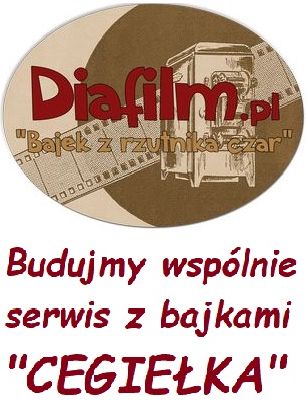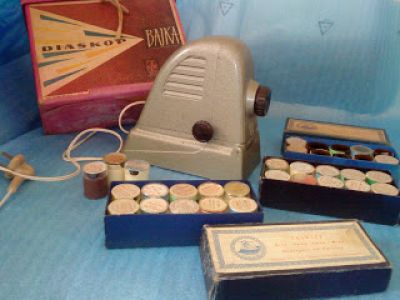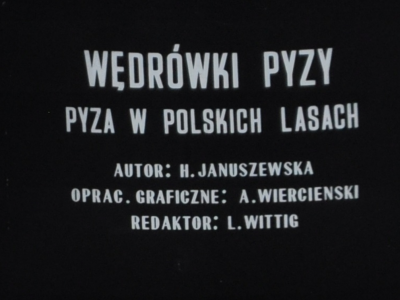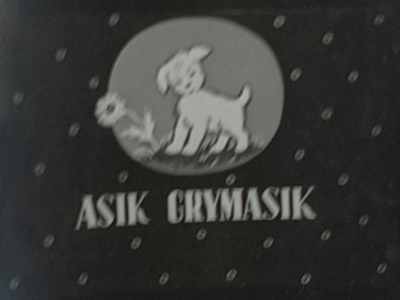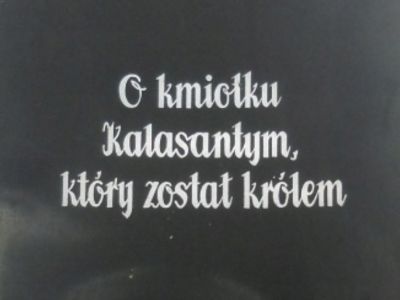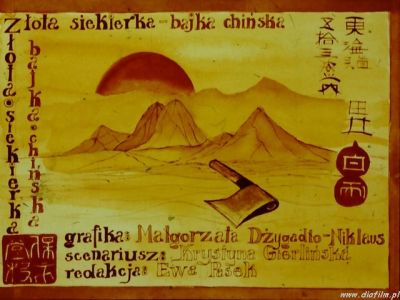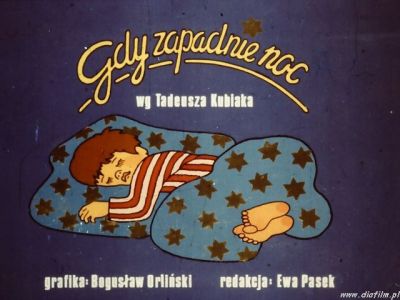


Newsletter
Zostań Redaktorem Serwisu
Drogi Miłośniku bajek z rzutnika,
Znalazłeś ciekawy artukuł w sieci, znalazłeś ciekawe zdjęcia lub posiadasz informację o nadchodzącym wydarzeniu lub takim , które się odbyło
a może napisałeś świetny artykuł na temat bajek z rzutnika
napisz proszę do mnie a ja zamieszczę podane przez Ciebie informacje w Serwicie.
* Serwis nie wypłaca gaż ani prowizji z tutyłu przekazania informacji lub artykułu w nim do zamieszczenia. W Serwisie zostaną zamieszczone informacje / dane, które nie łamią prawa. Zastrzegam sobie w szczególnych przypadkach do odmowy zamieszczenia informacji / artykułu bez podania przyczyn i bez prawa zgłaszającego do roszczeń z tego tytułu.
Theodoros Blitsas - miłośnik polskich bajek w Grecji
2012-11-27
Specjalnie dla Serwisu DiaFilmPL o swojej przygodzie z polskimi bajkami na rzutnik wydanymi w Grecji, która zminiła się w pasję kolekcjonerską pisze Theodoros Blitsas, ....
Jak widać nie tylko w Polsce popularne były i są nadal wydawane u nas bajki na rzutnik. Również w dość dalekiej dla nas Grecji były popularne i pozostawiły po sobie ślad. A o przygodzie greckiego kolekcjonera bajek przeczytacie poniżej.
Specjalnie dla Serwisu DiaFilmPL
Filmstrips: from Poland to Greece
My name is Theodoros and I am a Greek. Back in the 1960’s when still a little boy, was the time when I was first in contact with the static filmstrips. It was a gift from my grandfather, a red box with a metallic-green Diaskop-Bajka projector and a blue box with 10 “movies”. At later occasions, two more boxes with films were brought to me. It was the best gift and much awaited not only by me but by the whole gang of friends of that remote age.
You must understand that Greece of that time – and I think most of the civilized world - was still in the Dawn of the Technological Age, an era when television and home computers, not to mention the miracle of the World Wide Web, were still in an unheard of future and moving films, the short kind with duration of a few minutes, and their projectors were an expensive proposition for the majority of the middle class families. In most cities and neighborhoods entertainment for the children consisted still of the shadow theater shows of Karagiozis with paper cut figures behind a lighted cloth screen. So, this “cinema” was something very powerful for the imagination of the young children and even the adults. The whole gang was gathered usually at weekends afternoons in the backyard of my house and I was the cinema operator (!) The film was projected on a wall and someone from the audience – someone who had a nice clear voice – was elected to narrate the story. Of course during the show there were questions and various statements and interruptions. No supplementary music was thought to be necessary… When a film ended the next was chosen by loud voting! I believe sometimes we watched almost all the films I owned in one session. It made no difference if from the magic kingdom of Alice in Wonderland we stepped in the shoes of the astronauts fighting to save themselves from falling to the sun! The thrill was great! Sometimes when a film ended the vote decided to re-run it immediately!
The “projector” was a very sturdy thing and could be manhandled by the inquisitive hands of children adequately. It would need only common home electric power 220V. Sometimes, after a long time of use during the hot summer nights or perhaps because of sudden surges in the current, the light-bulb would pass away and that was a sad moment for the time, as the replacement was not very easy and had to be searched in special shops, also it stretched dearly the economics of the children allowances of the time. Some of the filmstrips also were wrecked or cut away and the parts forgotten and lost, during early experiments in cinematographic direction… Fortunately, the material the films were made of and the printing process was very good because even after 40-50 years of the manufacture date, you can still use them to project their contents.
After a few years the thrill of the filmstrips was of course left behind and the red box with the projector and the three little blue boxes with the films were forgotten in some corner of the storage room. It slept there for a long time, forgotten but not forgetting the sounds of children laughter, the bright beam plastering on the wall a window to show magic dreams…
Time passed away in the accelerating way it is accustomed to and suddenly you find yourself reminiscing of the “old days”. Fortunately today we have knowledge at our fingertips, in the form of computers and the Internet.
But let me backtrack a little. At a certain time I was introduced to computers. Not today’s high powered soul-less nearly inhuman and almost-AI machines, but “Uncle Clive’s magic box of tricks” the legendary Sinclair ZX Spectrum.
I walked along the first home computers and their evolution and their first interconnections through the first BBSs and the birth of the Internet. Then, when even home computers became “retro” things, I started a collection of various items from the “Dawn of the Technological Age”, but that’s another story… The relative thing is that at some time in my younger days I become an avid reader and collector of a certain type of space comics, “The Best Comics” series which consisted of 4 sub-titles: “Interplanetary”, “Amazing”, “Strange” and “Dynamic-Superman” – all titles are the English equivalent of the Greek . As I found out while searching the Internet, they were copies of a series of American comics under the titles "Strange Adventures", "Mystery in Space", “Tales of the Unexpected” and “Action Comics”.
By that time, I was used to searching the Internet and finding a lot of things about the items I collect – also not finding a lot of things… Anyway, some day in a Greek retro-collector site a friend posted a presentation of the Bajka projector. I was very interested and immediately I remembered my own projector and films which were gathering dust in the cellar. Soon after some archaeological excavations I had found the whole package – intact!
I rescued the package from its sorry companions and transported it with all necessary precautions to my laboratory. With reverence I inserted the power cable in the wall socket. I had high hopes that it would work as I knew that artifacts of that era were built to withstand the ravages of time. I pressed the on-off switch and voila! bright light painted a white rectangle on the wall! The projector was alive! I let the bulb reach a working temperature – after all it is the most sensitive part of the machine and the most difficult to find a replacement of – and then I inserted the first film, I don’t remember now which was. After cleaning the dust and adjusting the lens the picture was perfect. The device was working nicely after 40 years buried in lethe!
After a few minutes I decided not to overtax the old warrior and switched it off. As I was familiar with the procedures of scanlation with the old comics of my collection, I thought, why not preserving the filmstrips in scanned form? Even if I was lucky and the device operated smoothly it would be chancing to expect it to work for many more hours of operation. If the light bulb burned out where could I find another replacement? Since my time-machine was again broke due lack of theotimoline extract, I couldn’t travel back in time… !!! Were in the present era I would find the necessary components? Therefore I should preserve the device as long as possible and that was attainable only if it would operate for as short a time as possible. Just enough time for me to scan the filmstrips.
Meanwhile my friend’s presentation in the collector-site had aroused a host of other old-timers and some information started to trickle about the projectors and the filmstrips in Greece. I knew that projectors and films were sold by a now-defunct of course Greek company titled “Argo Films”. I found out that the company was established in Thessaloniki and obviously had used Polish filmstrips which they were translated by in-house Greek personnel. The transformation of each Polish filmstrip to the Greek version was done by hand, took many days and special painters, translators, photographers and other personnel took part in it.
The price for a filmstrip was 20 drachmas and there were boxes containing 10 filmstrips and inscribed “Cinescope Movies Argo-Film contains 10 movies Production by Photo-Cinematographic Studios Warsaw Poland”. The same company sold also the projector and there were special shops in Athens selling those filmstrips.
Here is a list of the Greek filmstrips I own: (Greek title, English translation, Polish original title)
Ο Γύρος της Γής από τον Μαγγελάνο, The Circumnavigation of the Earth by Magellan, Podroz Magellana dookola swiata
Η Αλίκη στη χώρα των θαυμάτων, Alice in Wonderland,
Διαπλανητικό Ταξίδι στην Αφροδίτη, Interplanetary Voyage to Venus
Ο Ευτυχισμένος Πρίγκηπας, The Happy Prince, Szczesliwy ksiaze
Ο Καραγκιόζης στο Διάστημα, Karagiozis in Space
Χονδρός και Λιγνός Καουμπόϋ, Fat and Slim Cowboys, Flip i Flap jako kowboje
Βίβλος- Γέννησις Η Φυγή στην Αίγυπτο, The Bible – Genesis and the Flight to Egypt
Ο τελευταίος των Μοϊκανών, The Last of the Mohicans, Ostatni Mohikanin
Ο Κόμης Μοντεχρίστος Α' μέρος, Count Montechristo, 1st part, Hrabia Monte Christo
Σλέϊντ ο τρόμος του λειβαδιού, Slade, the terror of the prairie
Υποβρύχιος Περιπέτεια, Underwater Adventure
Το Νησί των Θησαυρών, Treasure Island
Η Ληστεία τουΤραίνου, The Train Robbery, Jack Nevada - Wagon pocztow
Ζορρό ο Μασκοφόρος Εκδικητής, Zorro the masked avenger, Zorro cz4
Ροβινσών Κρούσος Α' μέρος, Ροβινσών Κρούσος Β' μέρος, Robinson Crusoe 1st part, 2nd part, Robinson Crusoe cz1
Τορπιλάκατος 209, Torpedo boat No 209
Τα τέκνα του Πλοιάρχου Γκράντ Α' μέρος, Τα τέκνα του Πλοιάρχου Γκράντ B' μέρος, The children of Captain Grand 1st part, 2nd part, Dzieci kapitana Granta cz1
Τα υψηλότερα βουνά της Ευρώπης, The Highest Mountains of Europe
Η κατάκτησις του Μεξικού, The conquest of Mexico, Zdobycie Meksyku
Πύραυλος Α1, Rocket A1, Rakieta ALFA 1
Τα άγρια θηρία της Αφρικής, The wild beasts of Africa
Βίβλος – Ιωάννης ο Βαπτιστής Τα πρώτα θαύματα του Ιησού, The Bible – John the Baptist, The first miracles of Jesus
Τορπιλάκατος "Επικίνδυνος Αποστολή", Torpedo boat “Dangerous Mission”
Αερομαχία πάνω από την Μάγχη, Airfight over the English Channel, Bitwa powietrzna nad kanalem la Manche
Ηρακλής, Hercules
Ιλιάδα Η πτώση της Τροίας, Iliad the Fall of Troy
Βαρώνος Μυγχάουζεν - Ταξίδι στο Φεγγάρι, Baron Munchausen – Voyage to the Moon, Przygody Munchhausena
Αίγυπτος, Egypt
Στο Παλάτι της Βασίλισσας των Παραμυθιών, At the Palace of the Queen of Fairytales, W palacu krolewny Bajki
These old filmstrips must be handled with care, in their original material form. Also, the projector can blow out and finding today replacement parts for a 40 year old extinct device is rather difficult. So, if a collector wants to re-play these filmstrips without having to endanger their existence he must preserve them in digital format, while the originals stay safe in their boxes.
Digitisation can be achieved properly by using special film-scanners witch have the best result but they cost hundreds of euros. This would be a option only for a state or private cultural preservation organisation with adequate funds. Since I am not one of those and as far as I know there isn’t something similar in Greece, I tried the poor – or amateur – man’s option. So, I project each filmstrip with the projector for one and only time. With a 3.2 Mpixel digital camera – and a very steady hand - I took photos of each picture of the filmstrip. These pictures were then modified so that I could extract the best clear result. Then the groups – one for each filmstrip – were packaged together with compression program winrar and made to cbr files which can be viewed with the cdisplay program. Furthermore, each filmstrip was made to a wmv movie file, sometimes with accompanying music. Lastly I put those cbr files in the web, which I view as the only safe and free worldwide storage medium available to today’s Humanity.
Friends who are interested in the subject can visit my own webpage about the filmstrips of Argo, here. It is written in Greek, but I think Google Translator or any other web translating machine can help you if you don’t know the language.
Lately, I have found some sites from other countries that cherish these artifacts and through which everyone who is interested in this subject can watch on-line the old filmstrips and even in some cases download them in their home computers. They are: from Hungary, from Russia and from France. Also, if you search in Youtube you will find a lot of American vintage filmstrips transformed in wmv movies. I would be interested if anyone can provide me with information for any other web site that I have not yet discovered.
I hope you found the above interesting and I wait to read about your own involvement in the subject of filmstrip collection, scanning and digital preservation.
Thank you.
Theodoros Blitsas
Athens, Hellas (Greece)
tblitsas@gmail.com
Przypomnij hasło
Zarejestruj się



Wszystkie prawa zastrzeżone: diafilm.pl
Projekt i wykonanie bprog.pl








